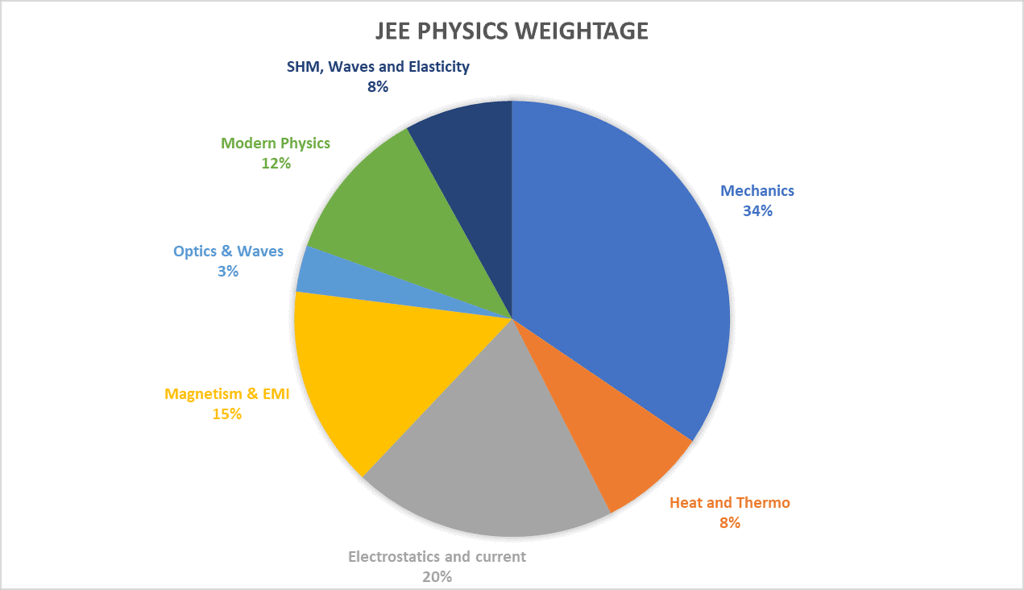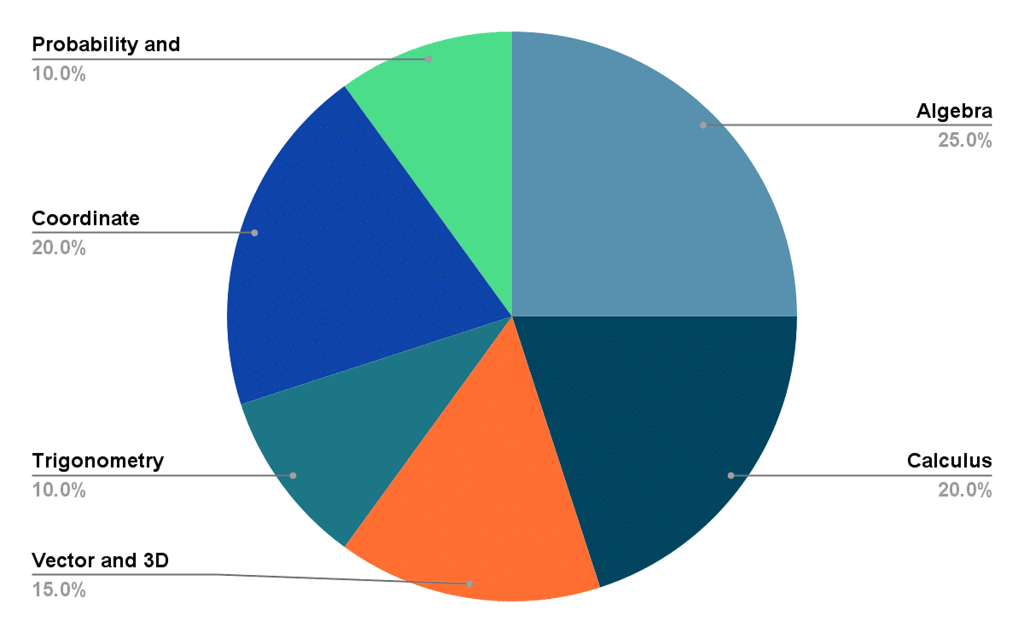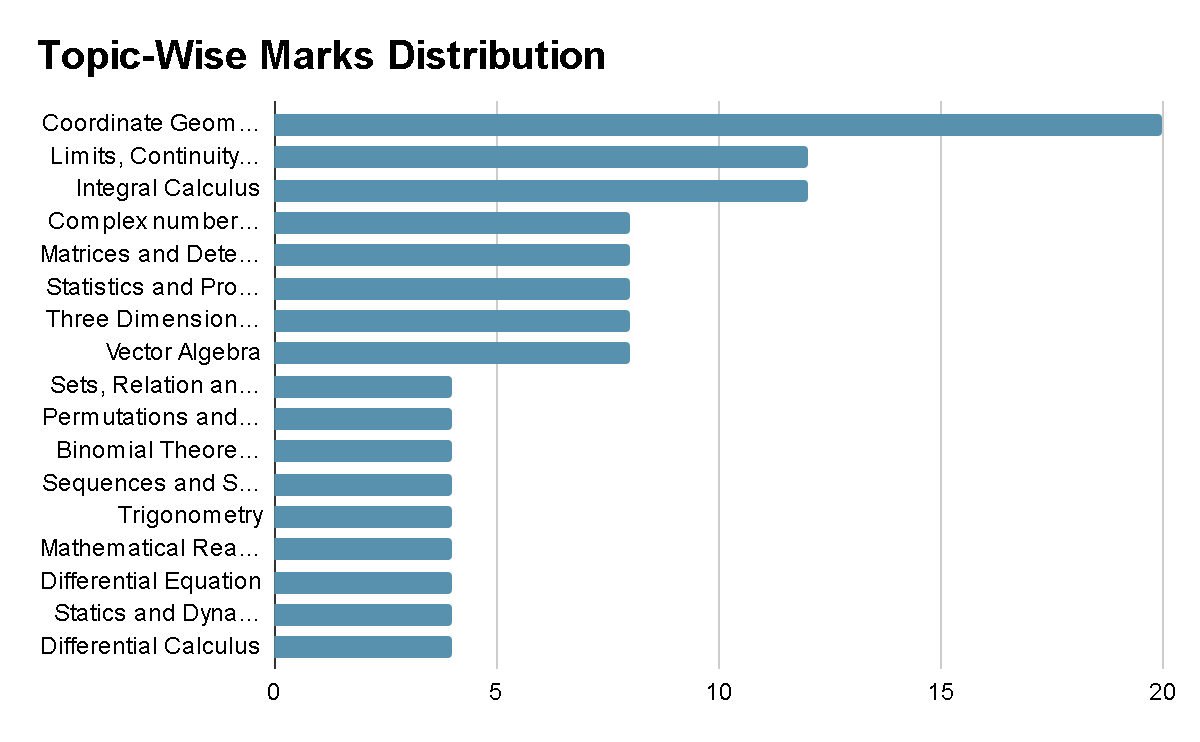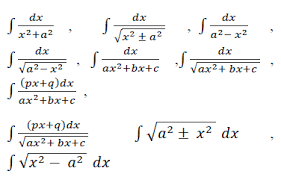JEE Main 2023 Syllabus
JEE Main has three different types of papers for various courses. Students have to choose the papers based on the course that they wanted to get into.
- Paper 1 – For admission to B. Tech/B.E.
- Paper 2A – For admission to B. Arch.
- Paper 2B – For admission in B. Planning.
The subjects for each paper are as mentioned:
Paper 1 | Paper 2A | Paper 2B |
Physics | Mathematics | Mathematics |
Chemistry | Aptitude | Aptitude |
Mathematics | Drawing | Planning related questions |
JEE Main 2023 Physics
The JEE Syllabus 2023 Physics paper will consist of two sections: Section A and Section B.
- Section A will contain multiple choice questions and will cover 80% of the theoretical aspect of physics.
- Section B will contain numerical questions that focus on the practical aspect of physics, making up the remaining 20% of the syllabus(Experimental Skills).
JEE Mains 2023 Physics Syllabus
Section A (Theory) | Section B (Experimental Skills) |
Physics and measurement | Vernier calipers- its uses to measure the internal and external diameter and depth of a vessel |
Rotational motion | Screw gauge-its use to determine the thickness/ diameter of a thin sheet/wire. |
Thermodynamics | Simple Pendulum-dissipation of energy by plotting a graph between the square of amplitude and time. |
Kinematics | Metre Scale - the mass of a given object by the principle of moments. |
Work, energy, and power | Young's modulus of elasticity of the material of a metallic wire. |
Properties of solids and liquids | The surface tension of water by capillary rise and the effect of detergents. |
Gravitation | Co-efficient of Viscosity of a given viscous liquid by measuring the terminal velocity of a given spherical body |
Laws of Motion | Plotting a cooling curve for the relationship between the temperature of a hot body and time |
Oscillations and waves | Speed of sound in air at room temperature using a resonance tube |
Electronic devices | Specific heat capacity of a given (i) solid and (ii) liquid by method of mixtures. |
Kinetic theory of gases | The resistivity of the material of a given wire using a meter bridge. |
Current electricity | The resistance of a given wire using Ohm's law. |
Communication systems | Potentiometer - (i) Comparison of emf of two primary cells. (ii) Determination of internal resistance of a cell. |
Electromagnetic induction and alternating currents | Resistance and figure of merit of a galvanometer by half deflection method. |
Magnetic effects of current and magnetism | The focal length of; (i) Convex mirror (ii) Concave mirror, and (ii) Convex lens, using the parallax method |
Optics | The plot of the angle of deviation vs angle of incidence for a triangular prism. |
Electromagnetic waves | Refractive index of a glass slab using a traveling microscope. |
Atoms and nuclei | Characteristic curves of a p-n junction diode in forward and reverse bias |
Electrostatics | Characteristic curves of a Zener diode and finding reverse breakdown voltage |
Dual nature of matter and radiation | Characteristic curves of a transistor and finding current gain and voltage gain. |
Identification of Diode. LED, Transistor. IC. Resistor. A capacitor from a mixed collection of such items. | |
Using a multimeter to (i) Identify the base of a transistor (ii) Distinguish between NPN and PNP type transistors (iii) See the unidirectional current in the case of a diode and an LED. (iv) Check the correctness or otherwise of a given electronic component (diode, transistor, or IC). |
JEE Main 2023 Mathematics
The JEE Main 2023 Mathematics exam will have 30 questions, divided into two sections: Section A and Section B.
- Section A will consist of multiple-choice questions, while Section B will contain numerical response questions.
- In Section B, candidates are required to answer any five out of ten questions.
The complete syllabus for Mathematics can be found below in the table.
JEE Mains 2023 Maths Syllabus
Topics | Topics |
Complex numbers and quadratic equations | Differential equations |
Matrices and determinants | Binomial theorem and its simple applications |
Sets, relations, and functions | Sequence and Series |
Mathematical induction | Vector algebra |
Permutations and combinations | Statistics and probability |
Mathematical reasoning | Trigonometry |
Limit, continuity, and differentiability | Coordinate geometry |
Integral calculus | Three-dimensional geometry |
JEE Main 2023 Chemistry
The JEE Mains 2023 Chemistry syllabus will have two sections one for theoretical questions (Section A) and another for numerical questions (Section B), with a total of 30 questions to be asked in the exam.
The syllabus is divided into three sections.
- Physical Chemistry
- Organic Chemistry
- Inorganic Chemistry
JEE Mains 2023 Chemistry Syllabus
Physical Chemistry | Inorganic Chemistry | Organic Chemistry |
Some basic concepts in chemistry | Classification of elements and periodicity in properties | Purification and characterization of organic compounds |
States of Matter | Hydrogen | Hydrocarbons |
Atomic structure | Block elements (alkali and alkaline earth metals) | Chemistry in everyday life |
Chemical bonding and molecular structure | P Block elements group 13 to group 18 elements | Principles related to practical chemistry |
Chemical thermodynamics | d- and f – block elements | Organic compounds containing halogens |
Solutions | Co-ordination compounds | Organic compounds containing oxygen |
Equilibrium | Environmental chemistry | Organic compounds containing nitrogen |
Redox reactions and electrochemistry | General principles and processes of isolation of metals | Polymers |
Chemical kinetics | Some basic principles of organic chemistry | |
Surface chemistry | Bio-molecules |
JEE Main 2023 Exam Pattern
JEE Main 2023 Important Topics: Weightage
Being familiar with the syllabus and exam format for JEE Main is essential for successful preparation. By understanding the key topics and the format of the exam, you can plan your study schedule and achieve your desired score. The JEE Main exam covers Physics, Chemistry, and Mathematics, so it is important to have a solid understanding of the main concepts in each subject.
Let us analyze the subjects, their syllabus, and the topic-wise weightage
Subject | Branch | Percent wise Coverage of Topics in JEE Main (past years) |
Physics | Mechanics | 30% |
Heat and Thermodynamics | 7% | |
Electrostatics and Current Electricity | 17% | |
Magnetism and Electromagnetic Induction | 13% | |
Optics and Waves | 3% | |
Modern Physics | 10% | |
Simple Harmonic Motion, Waves and Elasticity | 7% | |
Semiconductor Devices, Electromagnetic Waves and Principles of Communication | 13% | |
Chemistry | Organic Chemistry | 30% |
Inorganic Chemistry | 30% | |
Physical Chemistry | 40% | |
Mathematics | Coordinate Geometry | 17% |
Calculus | 27% | |
Algebra | 27% | |
Vector/3-D Geometry | 10% | |
Trigonometry | 6% | |
Sets and Relations, Mathematical Reasoning, Statistics | 13% |
JEE Main Physics Chapter-wise Weightage
The most asked chapters in JEE Main Physics are:
- Mechanics
- SHM, Waves and Thermodynamics
- Electrostatics
- Current Electricity
- Optics
- Magnetism and Electromagnetic Induction
- Modern Physics
Although the weightage may vary every year, but on a trend, their rough weightage has been observed as below:

JEE Main Maths Chapter Wise Weightage
The syllabus for mathematics in the Joint Entrance Examination (JEE) covers various topics from algebra, trigonometry, geometry, and calculus. The weightage of each topic in the JEE may vary from year to year.
The general weightage of topics covered in JEE Main Mathematics is as follows:


From the above data, we can conclude that topics like Coordinate Geometry, Limits, Continuity and Differentiability, and Calculus have a higher weightage compared to other topics. These topics require a deeper understanding of mathematical concepts and are heavily tested in competitive examinations.
EduRev experts have identified certain important topics in mathematics to be essential for success in the JEE Mains exam. These are sort of do-or-die chapters and can’t be left at any cost.
JEE Maths Study Material
JEE Maths study material includes a variety of resources such as textbooks, lecture notes, online tutorials, PYQs, and practice problems. It is important to use high-quality materials that align with the JEE syllabus and exam format.
EduRev offers a comprehensive range of courses to help you prepare for the JEE Mathematics Section. Each course listed below is tailor-made to help you gain the knowledge, skills, and confidence required to succeed in the JEE Mathematics Section.
JEE Main Syllabus 2023 for Paper 2A (BArch)
You can review the comprehensive JEE Main Paper 2 syllabus for BArch below. This syllabus encompasses subjects from Mathematics, Aptitude, and Drawing. The Mathematics syllabus for Paper 2A is similar to that of Paper 1.
JEE Mains 2023 Syllabus for Paper 2A (BArch)
Section | Topics |
Aptitude Part I |
|
Aptitude Part II |
|
Drawing | Sketching of scenes and activities from memory of urbanscape (public space, market, festivals, street scenes, monuments, recreational spaces, etc). landscape (riverfronts. Jungle. Gardens, trees. Plants, etc.) and rural life. |
JEE Main Syllabus 2023 for Paper 2B (B.Plan)
Candidates can check below JEE Main 2023 syllabus for paper 2B consisting of Maths, Aptitude, and Planning. The Mathematics syllabus for paper 2B is similar to Paper 1, while the Aptitude syllabus is the same as BArch which can be checked above.
JEE Mains 2023 Syllabus for Paper 2B (BPlan)
Units | Topics |
Unit 1- General Awareness | General knowledge questions and knowledge about prominent cities, development issues, government programs, etc. |
Unit 2- Social Science | The idea of nationalism, nationalism in India, the pre-modern world, 19th -century global economy, colonialism, and colonial cities, industrialization, resources, and development, types of resources, agriculture, water, mineral resources, industries, national economy; Human Settlements Power-sharing, federalism, political parties, democracy, the constitution of India Economic development- economic sectors, globalization, the concept of development, poverty; Population structure, social exclusion, and inequality, urbanization, rural development, colonial cities, |
Unit 3- Thinking Skills | Comprehension (unseen passage); map reading skills, scale, distance, direction, area, etc.; critical reasoning; understanding of charts, graphs, and tables; basic concepts of statistics and quantitative reasoning. |
Mathematics
The JEE Maths syllabus covers a wide range of mathematical concepts and topics, including algebra, trigonometry, geometry, calculus, and more. The syllabus is designed to test the student's understanding of the fundamental principles of mathematics and their ability to apply them to solve complex problems.
Here is a general outline of the units that are included in the JEE mathematics syllabus:
UNIT 1: Sets, Relations, and Functions
- Sets and their representation.
- Union, intersection, and complement of sets and their algebraic properties.
- Powerset.
- Relation, types of relations, equivalence relations.
- Functions; one-one, into and onto functions, the composition of functions.
UNIT 2: Complex Numbers and Quadratic Equations
- Complex numbers as ordered pairs of reals.
- Representation of complex numbers in the form (a+ib) and their representation in a plane, Argand diagram.
- Algebra of complex numbers, modulus and argument (or amplitude) of a complex number, square root of a complex number.
- Triangle inequality.
- Quadratic equations in real and complex number system and their solutions.
- The relation between roots and coefficients, nature of roots, the formation of quadratic equations with given roots.
UNIT 3: Matrices and Determinants
- Matrices: Algebra of matrices, types of matrices, and matrices of order two and three.
- Determinants: Properties of determinants, evaluation of determinants, the area of triangles using determinants.
- Adjoint and evaluation of inverse of a square matrix using determinants and elementary transformations.
- Test of consistency and solution of simultaneous linear equations in two or three variables using determinants and matrices.
UNIT 4: Permutations and Combinations
- The fundamental principle of counting.
- Permutation as an arrangement and combination as a selection.
- The meaning of P (n,r) and C (n,r), simple applications.
UNIT 5: Mathematical Inductions
- Principle of Mathematical Induction and its simple applications.
UNIT 6: Binomial Theorem and Its Simple Applications
- Binomial theorem for a positive integral index.
- General term and middle term.
- Properties of Binomial coefficients and simple applications.
- Arithmetic and geometric progressions, insertion of arithmetic, geometric means between two given numbers.
- The relation between A.M. and G.M sum up to n terms of special series: Sn, Sn2, Sn3.
- Arithmetico-Geometric progression.
UNIT 8: Limit, Continuity, and Differentiability
- Real-valued functions, algebra of functions, polynomials, rational, trigonometric, logarithmic and exponential functions, inverse functions.
- Graphs of simple functions.
- Limits, continuity, and differentiability.
- Differentiation of the sum, difference, product, and quotient of two functions.
- Differentiation of trigonometric, inverse trigonometric, logarithmic, exponential, composite and implicit functions; derivatives of order up to two.
- Rolle’s and Lagrange’s mean value theorems.
- Applications of derivatives: Rate of change of quantities, monotonic increasing and decreasing functions, Maxima, and minima of functions of one variable, tangents, and normal.
UNIT 9: Integral Calculus
Indefinite Integrals: Integral as an antiderivative, Fundamental Integrals involving algebraic, trigonometric, exponential, and logarithmic functions. Integrations by substitution, by parts, and by partial functions. Integration using trigonometric identities.
Evaluation of simple integrals of the type

Integral as the limit of a sum. The fundamental theorem of calculus
Definite Integrals:
Properties of definite integrals. Evaluation of definite integrals, determining areas of the regions bounded by simple curves in standard form.
UNIT 10: Differential Equations
- Ordinary differential equations, their order, and degree.
- Formation of differential equations.
- The solution of differential equations by the method of separation of variables.
- The solution of a homogeneous and linear differential equation of the type: dy/dx + P(x)y = Q(x)
UNIT 11: Co-ordinate Geometry
- Cartesian system of rectangular coordinates in a plane, distance formula, section formula, locus, and its equation, translation of axes, the slope of a line, parallel and perpendicular lines, intercepts of a line on the coordinate axes.
- Straight lines: Various forms of equations of a line, intersection of lines, angles between two lines, conditions for concurrence of three lines.
- Distance of a point from a line, equations of internal and external bisectors of angles between two lines, coordinates of the centroid, orthocentre, and circumcentre of a triangle, equation of the family of lines passing through the point of intersection of two lines.
- Circles, conic sections: Standard form of the equation of a circle, the general form of the equation of a circle, its radius and centre, equation of a circle when the endpoints of a diameter are given, points of intersection of a line and a circle with the centre at the origin and condition for a line to be tangent to a circle, equation of the tangent.
- Sections of conics, equations of conic sections (parabola, ellipse, and hyperbola) in standard forms, condition for y = mx + c to be a tangent and point (s) of tangency.
UNIT 12: Three-dimensional Geometry
- Coordinates of a point in space, the distance between two points.
- Section formula, direction ratios and direction cosines, the angle between two intersecting lines.
- Skew lines, the shortest distance between them and its equation.
- Equations of a line and a plane in different forms, the intersection of a line and a plane, coplanar lines.
- Vectors and scalars, the addition of vectors, components of a vector in two dimensions and three-dimensional space.
- Scalar products and vector products, and vector triple product.
UNIT 14: Statistics and Probability
- Measures of Dispersion: Calculation of mean, median, mode of grouped and ungrouped data calculation of standard deviation, variance and mean deviation for grouped and ungrouped data.
- Probability: Probability of an event, addition and multiplication theorems of probability, Baye’s theorem, probability distribution of a random variate, Bernoulli trials, and binomial distribution.
- Trigonometrical identities and equations.
- Trigonometrical functions, inverse trigonometrical functions, and their properties.
- Heights, and distance.
UNIT 16: Mathematical Reasoning
- Statement logical operations and, or, implies, implied by, if and only if, understanding of tautology, contradiction, converse, and contrapositive.




















